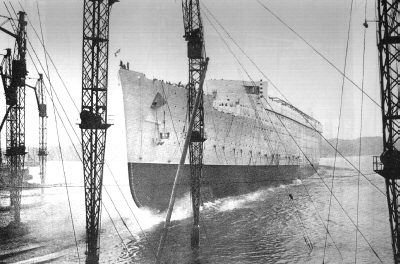

"534's" hull ready for launching.
The bare hull of the ship (with no engines or fittings yet) weighed about 35,500 tons. Launching it into the water was going to be difficult. The ship would have to slide down greased runners and then after entering the water of the Clyde river, would have to be stopped again! To accomplish this, 2,350 tons of drag chains were attached to the hull to act as brakes. Engineers calculated that the ship should travel 1,194 feet before stopping.
King George V attended the launching, and his wife, Queen Mary, performed the ceremony. The ship would be named after her, though it was rumored that 534's name had originally been intended to be "Victoria". Cunard had asked permission of the King to name the ship so: The delegation supposedly asked to name the ship "after England's greatest Queen....". At this point, the King interjected "Thank you. My wife will be delighted". This rather well known anecdote is not likely to be true though, and it is more likely that Cunard's recent merger with White-Star caused the change of naming policy. All White Star liners' names had ended with "ic". Cunard's with "ia". Perhaps these systems were being abandoned because of the merger.
On the launch day (even though it was raining), about 200,000 people showed up to see the largest ship ever launched take to the water. The river had been dredged and widened to take the ship. With the words "I name this ship "Queen Mary". I wish success to her and all who sail in her", the Queen pushed electric buttons which released the hull, which was painted white for the cameras.

The Queen Mary's hull takes to the water at last. Notice all the people getting a free ride on top of the hull.
The ship slid into the water, traveling 1196 feet. Just 2 feet more than predicted. The ship was then towed to a quayside or "fitting-out basin", where engines and the interior of the ship would be fitted.

Being fitted out. Here, the name letters are fixed on the bow. The letters are 2.5 feet high.
Inside, the Queen Mary had 12 decks, with the lower decks being for crew use only. The ship was divided into 3 classes, with the First (or "Cabin") Class cabins tending to be towards the middle of the ship, the Third Class towards the bow, and the Second Class towards the stern. The public rooms, especially in First Class were large and magnificent, containing artwork specially commissioned for the ship from leading artists of the 1930s.


The First Class Lounge, and the Main Hall.
It is not possible here to describe the enormous variety of rooms constructed on the ship at this time, but these images may give some idea of the richness of some of them. To look around these areas a little more, take the Virtual Tour on this site.
The First Class restaurant was the largest room afloat, 143 feet long and 118 feet wide: the full width of the ship. Other facilities constructed on board seem almost endless, with tennis and squash courts, cinemas, libraries, children's playrooms, barber shops, lounges, smoking rooms, writing rooms, gymnasia, and a nightclub - the "Verandah Grill".